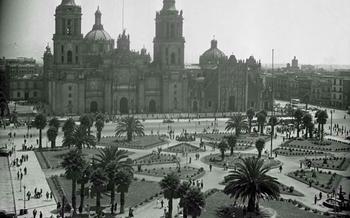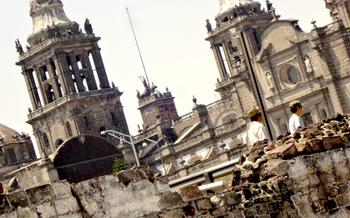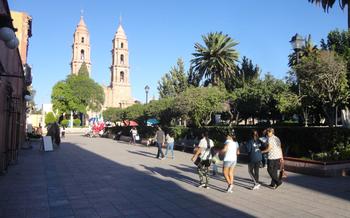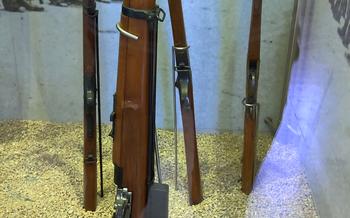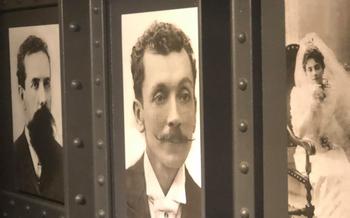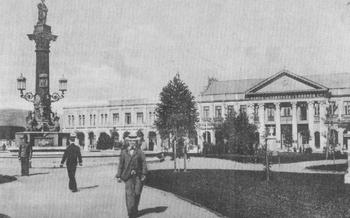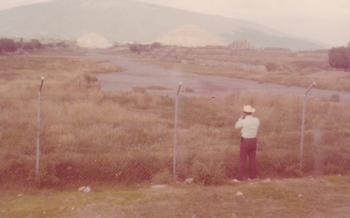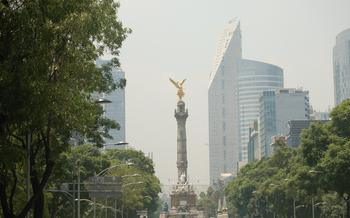
Palacio Nacional
- Historical Significance
- Unveiling the Murals: A Journey Through Mexican History
- A Glimpse into the Presidential Residence: Exploring the Salón de Recepciones
- The Presidential Seal: A Symbol of Authority
- The National Archives: A Treasure Trove of Mexican History
- Patio Mariano: A Serene Courtyard Steeped in History
- The Historic Bell: A Symbol of Independence
- Exploring the Presidential Offices: A Peek into the Seat of Power
- The Staircase of Honor: A Masterpiece of Architectural Design
- The Patio Central: A Place of Tranquility and Beauty
- The National Flag Ceremony: A Solemn Display of Patriotism
- The Changing of the Guard Ceremony: A Showcase of Military Precision
- Visiting the Palacio Nacional: Practical Information
- Opening Hours and Admission Fees
- Guided Tours and Self-Guided Exploration
- Accessibility for Visitors with Disabilities
- Tips for Planning Your Visit
- Unveiling the Secrets of the Palacio Nacional: Behind-the-Scenes Tours
Historical Significance
The Palacio Nacional, an iconic landmark in Mexico City, stands as a testament to Mexico's rich history and cultural heritage. Built on the site of the former Aztec palace, the Palacio Nacional has been the seat of Mexican government since the country gained independence in 182Over the centuries, it has witnessed countless historical events, from the signing of the Mexican Constitution to the Mexican Revolution. Within its walls, presidents have been sworn into office, foreign dignitaries have been received, and important decisions that have shaped the course of Mexico's history have been made. The Palacio Nacional is not just a building but a living symbol of Mexico's sovereignty and national identity.
Unveiling the Murals: A Journey Through Mexican History
Diego Rivera's murals in the Palacio Nacional are a testament to his artistic genius and his deep love for Mexico. His unique style, characterized by bold colors, simplified forms, and a blend of realism and symbolism, brings to life the rich history and culture of Mexico.
The murals, which cover an area of over 2,500 square meters, depict various themes, from the pre-Hispanic era to the Mexican Revolution. They showcase Rivera's profound understanding of Mexican history and his ability to fuse art with politics.
One of the most famous murals is "The History of Mexico," which depicts key moments in the country's history, from the arrival of the Spanish conquistadors to the Mexican Revolution. Rivera's use of symbolism and hidden meanings adds depth and complexity to his murals, inviting viewers to interpret and contemplate their significance.
Rivera's murals not only beautify the Palacio Nacional but also serve as a powerful reminder of Mexico's rich cultural heritage and its struggle for independence and social justice. They have had a profound impact on Mexican art and identity, inspiring generations of artists and helping to shape the nation's cultural and political consciousness.
A Glimpse into the Presidential Residence: Exploring the Salón de Recepciones
The Salón de Recepciones, or Hall of Receptions, is a grand and opulent chamber within the Palacio Nacional that serves as the official reception hall for the President of Mexico. This magnificent room has witnessed countless historical events, from lavish state banquets to solemn ceremonies. Its walls are adorned with intricate murals depicting the history and culture of Mexico, creating a visually stunning backdrop for official functions.
The Salón de Recepciones is particularly notable for its exquisite chandeliers, which are made of bronze and crystal and date back to the 19th century. The chandeliers illuminate the room with a warm and inviting glow, creating a sense of grandeur and elegance. The room also features a large fireplace, which adds to its cozy and inviting atmosphere.
Over the years, the Salón de Recepciones has hosted a variety of important events, including presidential inaugurations, diplomatic receptions, and state dinners. It has also been used for official ceremonies such as the signing of treaties and the awarding of national honors. The room's historical significance and grandeur make it a fitting setting for these momentous occasions.
The Salón de Recepciones is a symbol of Mexican presidential power and authority. It is a place where important decisions are made and where the nation's leaders come together to celebrate and commemorate significant events. The room's rich history and opulent décor make it a must-see for anyone interested in Mexican history and culture.
The Presidential Seal: A Symbol of Authority
The presidential seal, which is prominently displayed in the Salón de Recepciones, is a powerful symbol of Mexican presidential authority. The seal features a majestic eagle perched on a cactus, surrounded by the words "Estados Unidos Mexicanos." The eagle represents strength, power, and independence, while the cactus symbolizes the nation's resilience and ability to thrive in challenging conditions.
The presidential seal was first adopted in 1821, shortly after Mexico gained independence from Spain. It has undergone several modifications over the years, but its essential elements have remained the same. The seal is used on all official Mexican government documents and is displayed in government buildings throughout the country.
The presidential seal is a reminder of the power and authority of the Mexican presidency. It is a symbol of the nation's sovereignty and independence, and it serves as a reminder of the responsibilities that come with the office of the president.
The National Archives: A Treasure Trove of Mexican History
The National Archives, housed within the Palacio Nacional, serves as a repository of invaluable historical documents and artifacts that narrate the rich tapestry of Mexico's past. Within its walls, researchers, historians, and scholars embark on a journey through time, uncovering the secrets and stories that have shaped the nation's identity.
Among the treasures preserved within the National Archives are original manuscripts of the Mexican Constitution, dating back to the 19th century, as well as records of significant events that have left an indelible mark on the country's history. These documents provide a tangible connection to the past, allowing visitors to witness firsthand the struggles, triumphs, and challenges that have defined Mexico's path to independence and modernity.
The National Archives is not merely a repository of historical artifacts; it is a living, breathing institution that actively contributes to the preservation and dissemination of Mexico's cultural heritage. Through exhibitions, conferences, and educational programs, the Archives fosters a deeper understanding and appreciation of the nation's history, ensuring that the past remains a vital part of the present.
For those seeking to delve into the depths of Mexican history, the National Archives is an essential destination. Its vast collection of documents, artifacts, and resources provides a unique opportunity to explore the nation's rich tapestry of stories, traditions, and achievements.
Patio Mariano: A Serene Courtyard Steeped in History
Nestled within.
Adorned with lush greenery, intricate fountains, and elegant arches, the Patio Mariano showcases a blend of architectural styles that reflect Mexico's rich heritage. The courtyard's centerpiece is a majestic statue of the Virgin of Guadalupe, a symbol of hope and devotion for many Mexicans.
Throughout history, the Patio Mariano has witnessed numerous momentous events that have shaped Mexico's destiny. It served as a gathering place for celebrations, protests, and solemn ceremonies, each leaving an imprint on the courtyard's storied past.
The Patio Mariano stands as a testament to the resilience of the Mexican people, who have faced countless challenges and emerged stronger. It embodies the nation's unwavering faith and the enduring spirit that has guided Mexico through its journey as a sovereign nation.
The Historic Bell: A Symbol of Independence
One of the most iconic symbols of Mexican independence is the historic bell housed within the Palacio Nacional. Cast in 1810, the bell was rung by Miguel Hidalgo y Costilla, a priest and revolutionary leader, to call the people to arms against Spanish rule. The bell, known as the "Campana de Dolores," became a symbol of the Mexican War of Independence and a rallying point for the rebel forces.
The bell was originally located in the church of Nuestra Señora de los Dolores in the town of Dolores Hidalgo, Guanajuato. Hidalgo, who was the parish priest of the church, rang the bell on September 16, 1810, to signal the start of the uprising. The call to arms, known as the "Grito de Dolores," is considered the beginning of the Mexican War of Independence.
After the war, the bell was brought to Mexico City and placed in the Palacio Nacional. It was installed in the bell tower of the palace, where it remains to this day. Every year on Independence Day, the president of Mexico rings the bell to commemorate the start of the war and to honor the heroes who fought for Mexican independence.
The historic bell is a powerful symbol of Mexican independence and national pride. It is a reminder of the struggle for freedom and the sacrifices made by those who fought to achieve it. The bell is also a symbol of unity, as it represents the coming together of the Mexican people to fight for their independence.
Exploring the Presidential Offices: A Peek into the Seat of Power
The presidential offices, located within the Palacio Nacional, hold immense historical significance as the nerve center of Mexican politics. Here, presidents have made pivotal decisions, shaped policies, and guided the nation's destiny. The offices themselves exude an aura of power and authority, with their grand furnishings, intricate décor, and symbolic elements. Notable events, such as cabinet meetings, diplomatic negotiations, and presidential speeches, have unfolded within these walls, leaving an indelible mark on Mexico's political landscape.
The presidential offices are not merely functional spaces but also embodiments of the nation's sovereignty and the president's role as its leader. The presidential seal, prominently displayed, serves as a reminder of the office's authority and the weight of responsibility it carries. Exploring these offices offers a glimpse into the inner workings of Mexican politics and the decision-making processes that shape the nation's future.
The Staircase of Honor: A Masterpiece of Architectural Design
The Staircase of Honor, also known as the Grand Staircase, is a breathtaking architectural masterpiece that serves as the grand entrance to the Palacio Nacional. Every step you take up this grand staircase is a journey through history, elegance, and symbolism.
Designed by renowned architect Antonio Rivas Mercado, the staircase was constructed between 1902 and 1906 using white Carrara marble. Its sweeping curve and graceful lines create a sense of awe and grandeur. The intricate ironwork, adorned with intricate floral motifs and delicate scrollwork, adds a touch of lightness and elegance to the imposing structure.
The balustrade lining the staircase is adorned with elaborate statues representing important figures from Mexican history, including Cuauhtémoc, the last Aztec emperor, and Miguel Hidalgo, a hero of the Mexican War of Independence. These statues serve as silent witnesses to the events that have unfolded within the Palacio Nacional's walls.
The Staircase of Honor has been the stage for countless official ceremonies, receptions, and events throughout history. It has seen presidents sworn into office, foreign dignitaries welcomed, and important agreements signed. The footsteps of countless people, from ordinary citizens to heads of state, have echoed across its marble steps.
Beyond its functional purpose, the Staircase of Honor holds profound symbolic meaning. It represents the power and authority of the Mexican government. As visitors ascend the staircase, they are reminded of the importance of the institution they are about to enter. The staircase serves as a physical and metaphorical bridge between the people and their government.
Standing at the top of the Staircase of Honor, visitors are greeted by a breathtaking view of the Palacio Nacional's inner courtyard. The intricate details of the surrounding architecture, the colorful murals adorning the walls, and the vast expanse of the patio combine to create a truly awe-inspiring scene. It is a moment that encapsulates the grandeur and significance of this historic building.
The Patio Central: A Place of Tranquility and Beauty
The Patio Central, also known as the Main Courtyard, is a stunning architectural masterpiece that serves as the heart of the Palacio Nacional. Its expansive open space, surrounded by grand arcades and intricate columns, creates a harmonious blend of grandeur and tranquility. The courtyard's design, attributed to renowned architect Emilio del Moral, incorporates elements of both classical and contemporary styles, resulting in a visually captivating space.
As visitors step into the Patio Central, they are greeted by a serene atmosphere, a stark contrast to the bustling energy of the surrounding city. Verdant gardens, meticulously manicured lawns, and vibrant flowerbeds adorn the courtyard, providing a refreshing oasis amidst the urban landscape. The central fountain, with its cascading waters and intricate carvings, adds a touch of tranquility and elegance.
The National Flag Ceremony: A Solemn Display of Patriotism
Each morning, as the sun casts its golden rays upon the majestic Palacio Nacional, a solemn ceremony unfolds, captivating onlookers with its display of national pride and unity. The National Flag Ceremony, a time-honored tradition, pays homage to the Mexican flag, a symbol of sovereignty, independence, and the unwavering spirit of the Mexican people.
As the clock strikes 8 am, the courtyard of the Palacio Nacional transforms into a stage for this poignant ritual. The Presidential Guard, adorned in their impeccable uniforms, marches with precision, their footsteps echoing against the ancient walls of the palace. The crowd stands in respectful silence as the national anthem fills the air, stirring emotions of patriotism and reverence.
With synchronized movements, the soldiers raise the Mexican flag, its vibrant colors standing out against the clear blue sky. The crowd erupts in applause, their voices echoing their love for their country. The flag flutters in the breeze, symbolizing the resilience and unity of the Mexican nation.
The National Flag Ceremony is not merely a formality; it is a profound expression of national identity and a reminder of the sacrifices made by countless heroes who fought for Mexico's independence. It is a moment of reflection, a time to honor the past and embrace the future with renewed vigor.
Whether you are a local or a visitor, witnessing the National Flag Ceremony at the Palacio Nacional is an experience that will leave an indelible mark on your memory. It is a glimpse into the heart and soul of Mexico, a nation that celebrates its heritage with pride and unwavering devotion.
The Changing of the Guard Ceremony: A Showcase of Military Precision
The Changing of the Guard Ceremony at the Palacio Nacional is a spectacle that showcases the discipline and precision of the Mexican military. Every day at 10:00 AM, the ceremony unfolds with an unwavering routine that has been performed for generations.
The ceremony begins with the arrival of the outgoing guard, marching in perfect formation to the rhythmic beat of drums. They take their positions in front of the presidential residence, facing the assembled crowd. Simultaneously, the incoming guard, dressed in their resplendent uniforms, marches onto the scene, their footsteps echoing through the historic courtyard.
As the two guards face each other, the ceremony reaches its climax. The outgoing guard commander hands over the national flag to the incoming commander, symbolizing the peaceful transition of power and authority. The crowd erupts into applause, honoring the dedication and commitment of the Mexican military.
The Changing of the Guard Ceremony is not merely a display of military prowess but also a testament to Mexico's rich history and traditions. It is a poignant reminder of the sacrifices made by those who have served and continue to serve the nation. Whether you are a history buff, a lover of military pageantry, or simply a curious traveler, witnessing this ceremony is an experience that will leave a lasting impression.
Visiting the Palacio Nacional: Practical Information
Opening Hours and Admission Fees
The Palacio Nacional is open to the public from Tuesday to Sunday, from 9:00 am to 5:00 pm. Admission is free of charge, allowing visitors to explore the palace's grand halls, courtyards, and murals without any financial burden.
Guided Tours and Self-Guided Exploration
Guided tours are available in both English and Spanish, providing visitors with a deeper understanding of the palace's history, architecture, and significance. These tours are led by knowledgeable guides who can answer questions and share insights about the palace's many treasures. For those who prefer a more independent exploration, self-guided tours are also an option, allowing visitors to wander through the palace at their own pace and discover its secrets.
Accessibility for Visitors with Disabilities
The Palacio Nacional is committed to ensuring accessibility for all visitors, including those with disabilities. The palace is wheelchair accessible, with ramps and elevators providing easy access to all levels. Additionally, wheelchairs are available for rent on-site, making it easier for visitors with mobility challenges to explore the palace's many wonders.
Tips for Planning Your Visit
To make the most of your visit to the Palacio Nacional, consider the following tips:
- Plan your visit for a weekday if possible, as weekends tend to be more crowded.
- Arrive early in the morning or late in the afternoon to avoid the midday heat and crowds.
- Wear comfortable shoes, as you'll be doing a lot of walking.
- Bring a camera to capture the palace's many photo opportunities.
- Take advantage of the free guided tours or rent an audio guide for a more in-depth experience.
- Allow plenty of time to explore the palace, as there is much to see and discover.
Unveiling the Secrets of the Palacio Nacional: Behind-the-Scenes Tours
Beyond the public areas of the Palacio Nacional, a world of hidden treasures awaits discovery through exclusive behind-the-scenes tours. These tours offer a unique opportunity to delve deeper into the palace's history, art, and architecture, granting visitors access to restricted areas and providing insights into the inner workings of the Mexican government.
To embark on this extraordinary journey, reservations must be made in advance, as these tours are highly sought after. Once arrangements are confirmed, prepare to be captivated as knowledgeable guides lead you through secret passageways, revealing hidden murals, historical artifacts, and forgotten chambers that hold untold stories.
These tours provide an unprecedented glimpse into the Palacio Nacional's fascinating past, allowing visitors to uncover the secrets that lie beneath its grand facade. From the private chambers of former presidents to hidden courtyards and underground tunnels, every corner of the palace reveals a new layer of its rich history.
Whether you're a history buff, an architecture enthusiast, or simply curious about what lies beyond the public eye, these behind-the-scenes tours offer an unforgettable experience that will leave you with a deeper understanding and appreciation for the Palacio Nacional and its enduring legacy.
